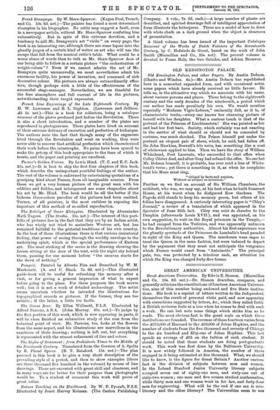OLD KENSINGTON PALACE.
0/d Kensington Palace, and other Papers. By Austin Dobson. (Chatto and Windus. 6s.)—Mr. Austin Dobson has republished here in a somewhat expanded form, and with occasional notes, some papers which have already received no little favour. He tells us, in the attractive way which we associate with his name, about various persons and places. These belong to the eighteenth century and the early decades of the nineteenth, a period which our author has made peculiarly his own. We would mention especially "Madame Vigee. -Lebrun," eminently full, as it is, of characteristic traits,—every one knows her charming picture of herself with her daughter. What a curious touch is that of the portrait of the Princess of Liechtenstein ! She was painted as Iris and had her feet bare. Society, which certainly was not exacting in the matter of what should or should not be concealed by costume, was much shocked. The Prince himself put under the portrait an elegant pair of shoes, which, he said, had fallen off. Sir John Hawkins, Boswell's bete noire, has something like a coat of whitewash applied to him. Then we have the story of William Whitehead, Poet Laureate, who succeeded to that office when Colley Cibber died, and after Gray had refused the offer. No one but Mr. Dobson himself, it is probable, has ever read a line of White- head's verse ; yet there is something in it, as when he complains that his Muse must sing,
"obliged by facts and pension, Without or subject or invention."
Further on we find an account of Sir William Chambers, the architect, who was, we may say, at his best when he built Somerset House, at his worst when he disfigured Kew Gardens. The Pagoda still stands to keep his memory green, but others of his follies have disappeared. A curiously interesting paper is " Clery's Journal," a review of a translation of which appeared in the Spectator of June 25th last. Cl6ry was valet de chambre to the Dauphin (afterwards Louis XITII.), and was appointed, on his own suggestion, to wait on the Royal prisoners in the Temple,— he had escaped from the Tuileries, and was apparently unknown to the Revolutionary authorities. Almost his first experience was the ghastly spectacle of the Princesse de Lamballe's head paraded in sight of the King and Queen. The murderers were eager to treat the Queen in the same fashion, but were induced to depart by the argument that they must not anticipate the vengeance which France would exact from "Antoinette." The principal gate, too, was protected by a tricolour sash, an attention for which the King was charged forty-five francs.






















































 Previous page
Previous page